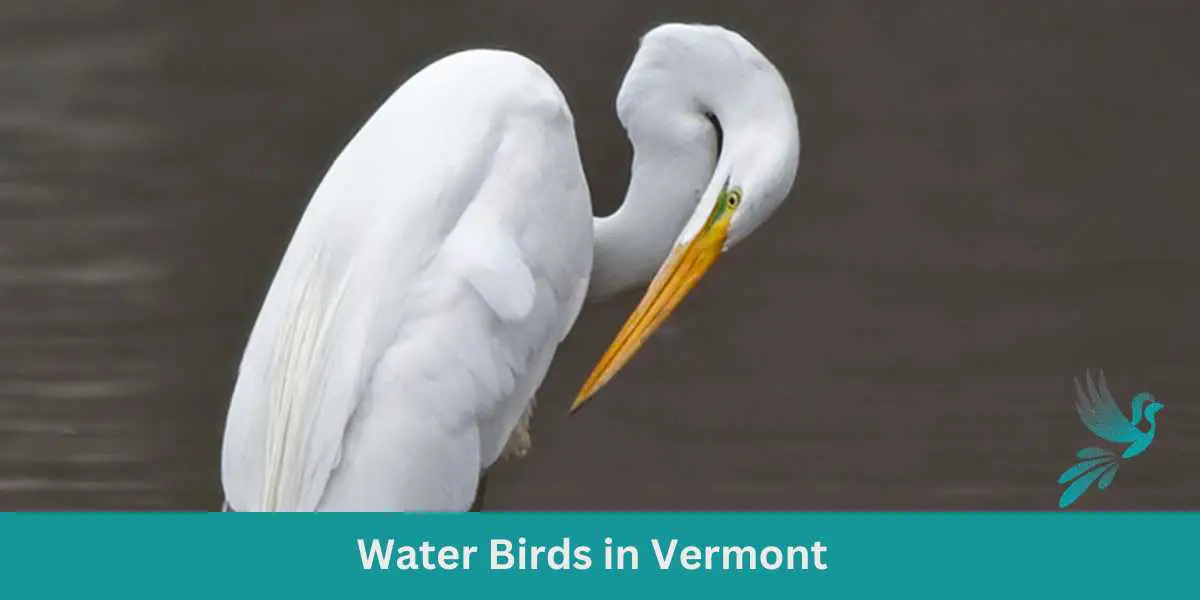Vermont, with its myriad of lakes, rivers, and marshes, is home to a spectacular array of water birds that significantly enrich its diverse ecosystem.
Vermont water birds
| Water Bird Species | Frequency in Vermont | Specific Locations in Vermont |
|---|---|---|
| American White Pelican | Uncommon | Champlain Valley |
| Double-Crested Cormorant | Common | Lake Champlain, Lake Memphremagog |
| Great Blue Heron | Very Common | Statewide in wetland areas and riverbanks |
| Great Egret | Uncommon | Missisquoi National Wildlife Refuge |
| Snowy Egret | Uncommon | Missisquoi National Wildlife Refuge |
| Green Heron | Uncommon | Woodbury Lake, East Barre Dam |
| Black-Crowned Night-Heron | Uncommon | Missisquoi National Wildlife Refuge |
| Mallard | Very Common | Statewide in wetland areas |
| Wood Duck | Common | Statewide, particularly in northern parts |
| Blue-Winged Teal | Common | Missisquoi National Wildlife Refuge |
| Northern Pintail | Uncommon | Missisquoi National Wildlife Refuge |
| Common Goldeneye | Common | Lake Champlain, Connecticut River |
| Hooded Merganser | Common | Statewide in lakes and ponds |
| Common Merganser | Common | Statewide in rivers and lakes |
| Red-Breasted Merganser | Uncommon | Lake Champlain during migration |
| American Coot | Uncommon | Lake Champlain, Missisquoi National Wildlife Refuge |
| Sandhill Crane | Uncommon | Champlain Valley |
| American Wigeon | Common | Lake Champlain, Missisquoi National Wildlife Refuge |
| Osprey | Uncommon | Dead Creek Wildlife Management Area |
| Common Loon | Uncommon | Northeast Kingdom lakes |
| Pied-Billed Grebe | Uncommon | Lake Champlain, Missisquoi National Wildlife Refuge |
| Ring-Billed Gull | Very Common | Lake Champlain, city landfill sites |
| Herring Gull | Very Common | Lake Champlain, city landfill sites |
| Great Black-backed Gull | Common | Lake Champlain, city landfill sites |
| Caspian Tern | Uncommon | Lake Champlain during summer |
Water Bird Species Found in Vermont
American White Pelican


| Feature | Measurement |
|---|---|
| Scientific Name | Pelecanus erythrorhynchos |
| Length | 50–70 in |
| Wingspan | 95–120 in |
| Weight | 3.5 and 13.6 kg |
The American White Pelican (Pelecanus erythrorhynchos) is one of North America’s largest birds, distinguished by its brilliant white plumage, elongated orange bill, and massive wingspan, which can extend up to 3 meters. This bird has a unique appearance with its distinctive pouch used for feeding and a “horn” on the upper part of the bill during the breeding season. Though a large bird, it is very graceful in flight, often seen soaring in flocks in a V formation.
American White Pelicans inhabit lakes, marshes, and salt bays, and despite their size, they are excellent swimmers. They feed primarily on fish, using a cooperative hunting strategy where they encircle schools of fish in shallow water and then scoop them up in their bill pouches. Unlike their brown pelican relatives, they do not dive for their food. During the breeding season, these pelicans will nest in colonies on islands in freshwater lakes.
Double-crested cormorant

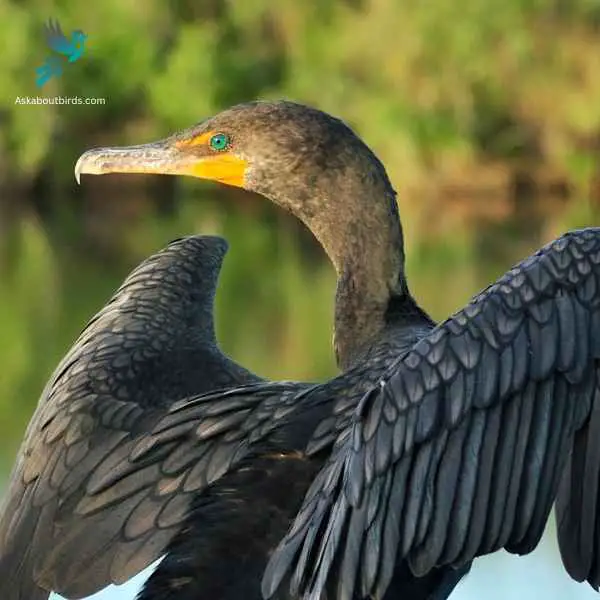
| Feature | Measurement |
|---|---|
| Scientific Name | Nannopterum auritum |
| Length | 28–35 in |
| Wingspan | 45–48 in |
| Weight | 1.2–2.5 kg |
The Double-Crested Cormorant (Phalacrocorax auritus) is a large waterbird known for its long neck, hooked bill, and almost entirely black body. The species gets its name from the two small patches of tufted feathers or “crests” found on the heads of breeding adults, one on each side. These birds are strong swimmers that propel themselves underwater with their webbed feet, their bodies submerged and necks above the water surface, giving them a characteristic snake-like appearance when swimming.
Double-Crested Cormorants are widely distributed across North America and can be found in a variety of aquatic environments including freshwater lakes, coastal areas, and rivers. Their diet primarily consists of fish, which they catch by diving from the water’s surface. Often seen perched with wings outstretched to dry after fishing, these cormorants nest in trees, on the ground, or on cliff edges, usually in colonies. While they have rebounded from decreases in the mid-20th century due to DDT-related reproductive failures, they face ongoing threats from habitat loss, entanglement in fishing gear, and conflicts with fisheries over their consumption of fish. Protection and careful management of their habitats are key to their ongoing conservation.
Great Blue Heron


| Feature | Measurement |
|---|---|
| Scientific Name | Ardea herodias |
| Length | 36–54 in |
| Wingspan | 66–79 in |
| Weight | 1.82–3.6 kgs |
Great Blue Herons are the largest heron species in North America, is distinguished by its tall stature and unique blue-gray plumage.
Measuring up to 4.5 feet tall with a wingspan of approximately 6.5 feet, the bird features a long, pointed bill, a white head with a black eye stripe extending to slender black plumes, and robust, elongated legs. Its distinctive flight pattern, forming a tight “S” shape with its neck, sets it apart from similar large birds, like cranes.
Inhabiting various wetland habitats, including marshes, lakes, rivers, and coastal regions throughout much of North and Central America, the Great Blue Heron is a wading bird. Often seen poised statue-like at the water’s edge, these birds are expert hunters, spearing fish and capturing small animals with their sharp bills.
Great Egret


| Feature | Measurement |
|---|---|
| Scientific Name | Ardea alba |
| Length | 31 to 41 in |
| Wingspan | 52 to 67 in |
| Weight | 1.5 to 3.3 lbs |
The Great Egret (Ardea alba), also known as the Common Egret, is a large, elegant wading bird recognized for its brilliant white plumage, slender black legs, and long, dagger-like yellow bill.
With a height of up to 3.3 feet and a wingspan of 52 to 67 inches, this bird is amongst the largest of the heron species. Its stately appearance and serene comportment have made it a popular symbol in many cultures and an eye-catching sight in its habitats.
Found across all continents except Antarctica, the Great Egret resides in both fresh and saltwater wetlands, including marshes, ponds, and coastal areas. It feeds mainly on fish, but it also hunts amphibians, small mammals, and invertebrates.
Snowy Egret

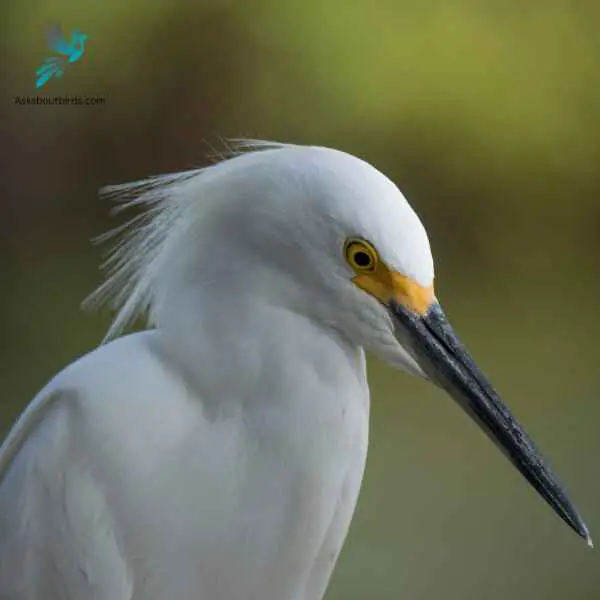
| Feature | Measurement |
|---|---|
| Scientific Name | Egretta thula |
| Length | 22.1–26.0 in |
| Wingspan | 39.4 in |
| Weight | 370 g |
The Snowy Egret (Egretta thula) is a small and active wading bird, celebrated for its delicate beauty. It sports an entirely white plumage that appears to glow against its black bill and legs, and striking yellow feet, which often play a crucial role in luring prey during feeding.
The Snowy Egret is further adorned with fine, plume-like feathers on its head, neck, and back during the breeding season, making it one of the more distinctive heron species.
Inhabiting wetland areas across the Americas, the Snowy Egret can be found in marshes, swamps, shorelines, and tidal flats where it feeds primarily on fish, but also consumes insects, crustaceans, and small reptiles.
Green Heron

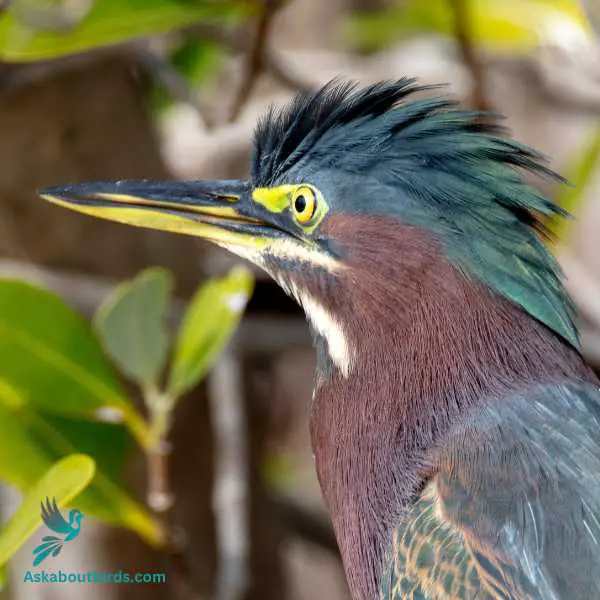
| Feature | Measurement |
|---|---|
| Scientific Name | Butorides virescens |
| Length | 16-18 inches |
| Wingspan | 25-27 inches |
| Weight | 6-7 ounces |
The Green Heron is a small heron found in North America, notable for its deep green back and chestnut body, as well as its unique fishing tactics.
Appearance: Green Herons are dark and compact birds with a glossy, greenish-black cap, a greenish back and wings, and chestnut neck and belly. The bill is long, dark and sharply pointed. Their legs are bright orange or yellow. Young birds are duller in color, with a dark top and streaked brown front.
Diet: The Green Heron’s diet is quite varied, consisting mostly of small fish, but also includes insects, spiders, and sometimes amphibians and small mammals. It’s known for its tool-using behavior where it drops bait onto the water’s surface to attract fish.
Reproduction: Green Herons are solitary birds except during the breeding season, where they form monogamous pairs. Nests are typically built in trees or shrubs near water. Females lay 2 to 5 pale blue-green eggs that both parents incubate.
Black-Crowned Night-Heron
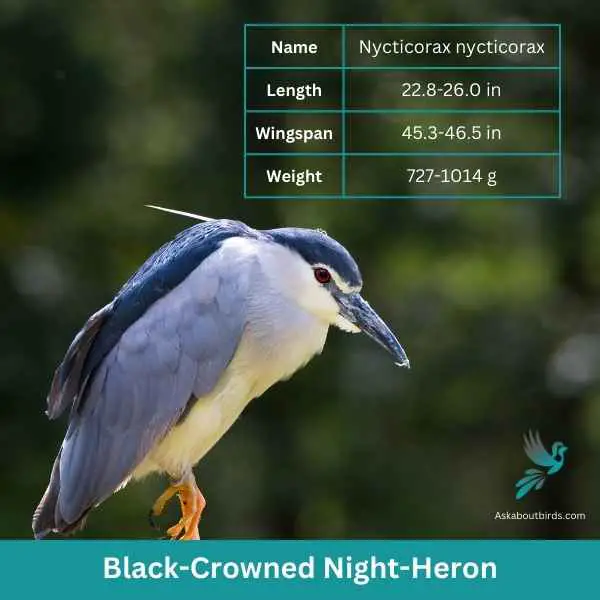
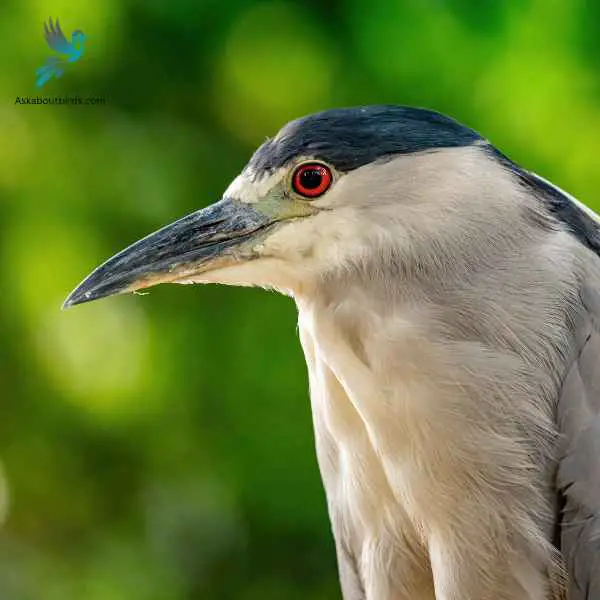
| Feature | Measurement |
|---|---|
| Scientific Name | Nycticorax nycticorax |
| Length | 22.8-26.0 in |
| Wingspan | 45.3-46.5 in |
| Weight | 727-1014 g |
The Black-Crowned Night-Heron (Nycticorax nycticorax) is a medium-sized heron species known for its distinct nocturnal habits and characteristic appearance. The bird displays a stocky silhouette, with a black crown and back, contrasting starkly with its light grey wings and white underparts.
Its eyes are large and red, adapted for its night-time activities, and its legs are relatively short for a heron. The bill is sturdy and black, and during the breeding season, two to three long white plumes extend from the back of the head.
Residing in a wide variety of wetland habitats, from freshwater marshes to coastal regions, the Black-Crowned Night-Heron is found across a large global range, including the Americas, Europe, Asia, and Africa. The species primarily feeds on fish and invertebrates, but it is known to be opportunistic and will also eat small mammals, birds, and eggs.
Mallard
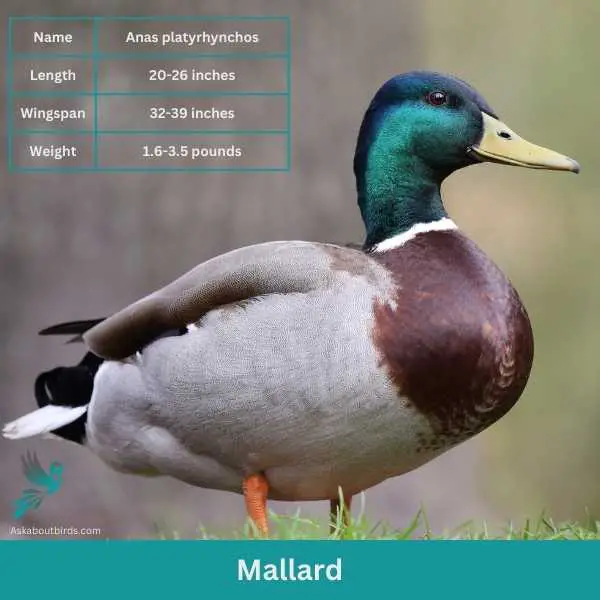
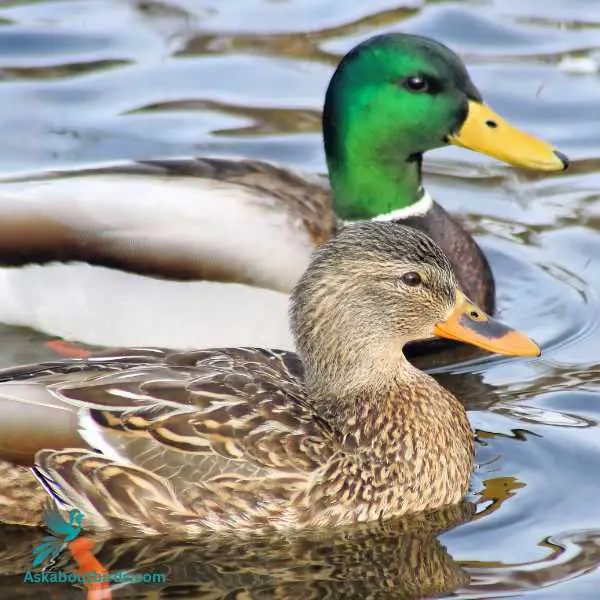
| Feature | Measurement |
|---|---|
| Scientific Name | Anas platyrhynchos |
| Length | 20-26 inches |
| Wingspan | 32-39 inches |
| Weight | 1.6-3.5 pounds |
The Mallard, one of the most recognizable of all ducks, is distinguished by its classic “quack” and its common presence in city parks and wild wetlands.
Appearance: Mallards are large ducks with a hefty body and rounded head. The male is notable for its glossy green head, gray body, and black tail-curl, while the female is mottled brown with an orange-brown bill. Both sexes have a white-bordered, blue “speculum” patch in the wing.
Diet: Mallards are omnivorous, dabbling ducks that eat a wide variety of foods. They are known to feed on aquatic vegetation, insects, worms, and grains. In city parks, they are often seen eating bread, popcorn, and other food provided by humans, although such items are not part of their natural diet.
Reproduction: Mallards nest on the ground on dry land that is close to water, under cover of tall grass or other vegetation. The female typically lays around 8 to 13 eggs and incubates them herself.
Wood Duck

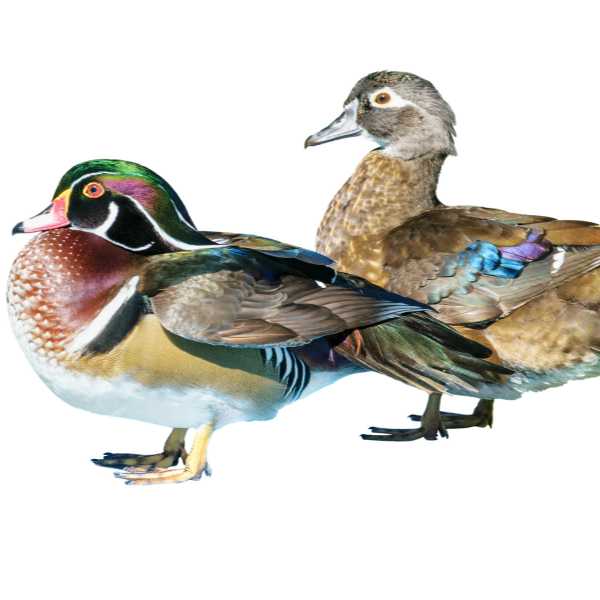
Listen:
Scientific Name: Aix sponsa
Length: 19 to 21 in
Wingspan: 26 to 29 in
Weight: 16.0-30.4 oz
The Wood Duck is an exquisitely colorful waterfowl known for its unique nesting habits and is commonly seen in wooded swamps, marshes, and streams across North America.
Appearance: With their dazzling plumage, Wood Ducks are among the most stunning birds. Males display a multitude of colors, including a green and purple crested head, red eyes, and a white-striped chest, all contrasted with a bronze-colored body. Females, though more subdued with a gray-brown body and white eye-ring, also possess their own charm.
Diet: Wood Ducks have a diverse diet that includes seeds, fruits, and insects, as well as other invertebrates. Their broad diet helps them to adapt to a variety of habitats, whether in the wild or in urban areas with suitable nesting sites.
Reproduction: Unlike most other ducks, Wood Ducks prefer to nest in tree cavities near water, leading to their common name. They will also readily use nest boxes if they’re available. A typical clutch consists of 9 to 14 eggs, which the female incubates alone.
Blue-winged Teal
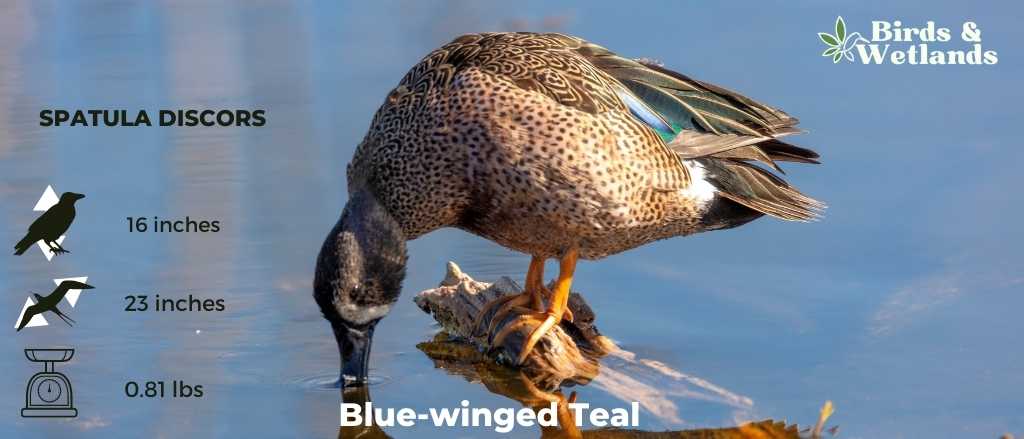
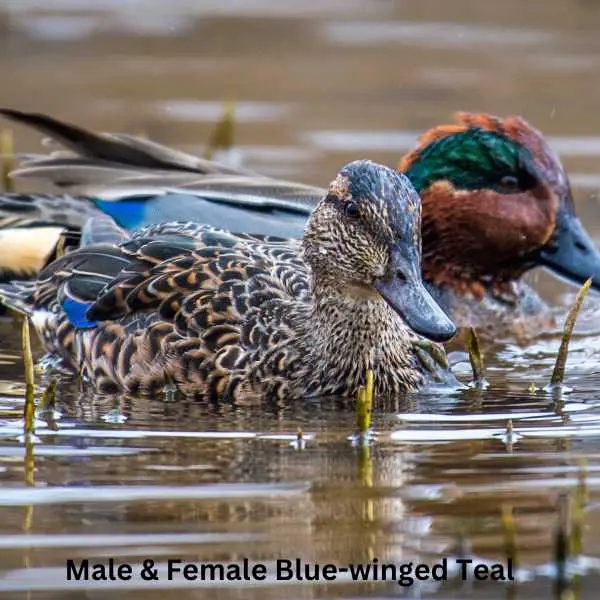
Listen to Blue-winged Teal
Scientific Name: Spatula discors
Length: 16 in
Wingspan: 23 in
Weight: 13 oz
The Blue-winged Teal is a small species of dabbling duck known for its striking plumage and its extensive migratory habits.
Appearance: Male Blue-winged Teals are quite colorful, with a slate gray head and neck, a white crescent in front of the eyes, and a predominantly brown body with specks of black. The name “Blue-winged” comes from the patch of blue feathers visible on their wings during flight. Females, in contrast, are primarily brown and subtly mottled to provide camouflage.
Diet: The Blue-winged Teal feeds mainly on plant matter, such as seeds and aquatic vegetation. However, they also supplement their diet with small invertebrates, especially during the breeding season. They are known for their “dabbling” behavior, where they feed at the surface of the water rather than diving.
Reproduction: Blue-winged Teals prefer to nest on the ground in grassy areas near water. The female typically lays a clutch of 9 to 13 eggs, which she incubates alone for about three weeks. After hatching, the ducklings can feed themselves but remain under the mother’s protection until they are capable of flying.
Northern Pintail

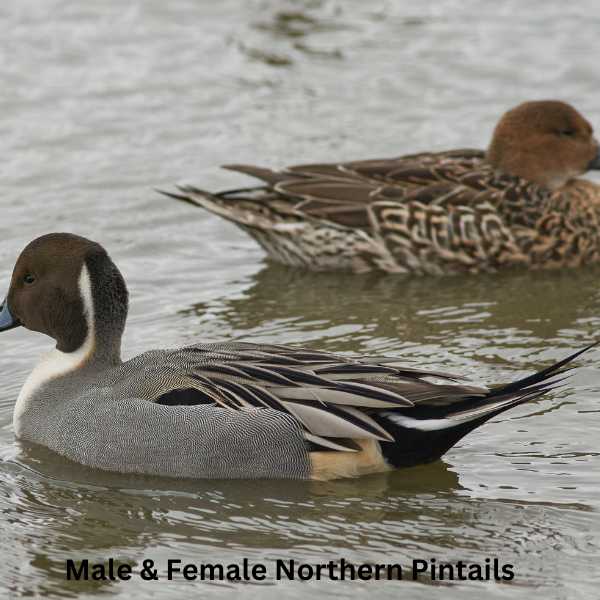
Listen to Northern Pintail
Scientific Name: Anas acuta
Length: 23–30 in
Wingspan: 31–37 in
Weight: 1 –3 lb
The Northern Pintail is a graceful species of duck recognized for their elegance in flight and their sleek bodies and long tails which is pin-shaped.
Male Northern Pintails are celebrated for their distinctive appearance, featuring a chocolate brown head, a white neck, and a grayish body. The most notable characteristic is the long, pointed tail feathers, which give this species its name. Females are more understated in color, sporting a mottled brown plumage.
Diet: Consists primarily of plant matter, including seeds and aquatic vegetation. They are also known to eat insects, especially during the breeding season. The Northern Pintail is often seen dabbling and upending in water bodies to forage for food.
Reproduction: Northern Pintails usually nest on the ground, near water bodies. The female lays a clutch of 7 to 9 eggs and is solely responsible for their incubation, which lasts for about three weeks.


Listen to American Wigeon
Scientific Name: Bucephala clangula
Length: 18-20 inches
Wingspan: 30.3-32.7 inches
Weight: 1.8-2.2 lbs
The Common Goldeneye is a medium-sized diving duck, recognized for its golden-yellow eye and distinct whistling sound made during flight.
Appearance: Male Common Goldeneyes have a glossy green-black head, a circular white patch between the eye and the bill, and a golden-yellow eye. They have a dark back and white underparts. Females have a chocolate-brown head and a similar golden-yellow eye but lack the white facial patch.
Diet: Common Goldeneyes feed on a variety of aquatic life including crustaceans, insects, and small fish. They are diving ducks and will often plunge below the surface to search for food.
Reproduction: The female nests in tree cavities near water, typically laying between six and fifteen eggs. After hatching, the young ducks will follow their mother, who guides them to feeding areas but does not feed them directly.
Hooded Merganser
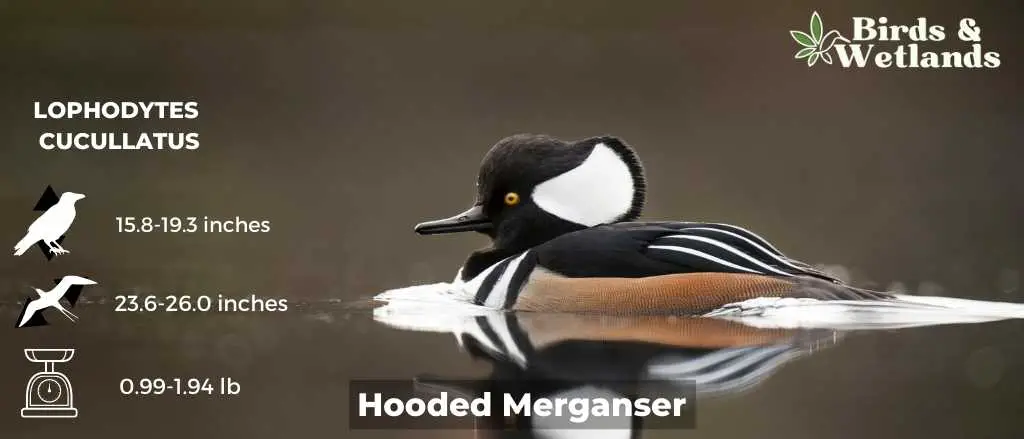
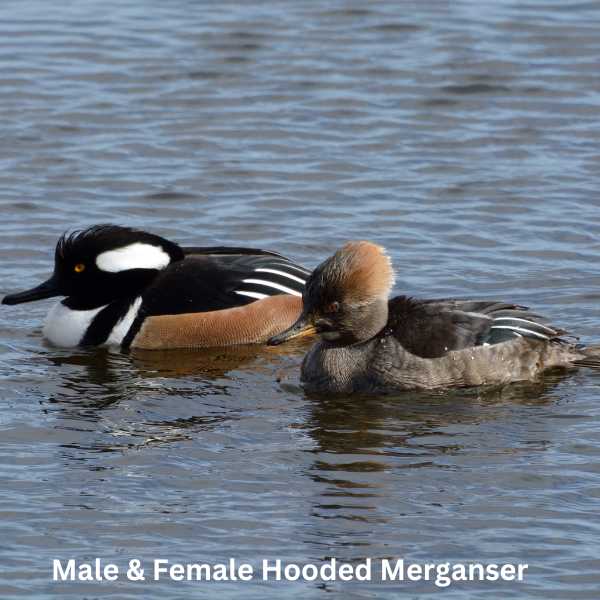
Listen to Hooded Merganser
Scientific Name: Lophodytes cucullatus
Length: 15.8-19.3 in
Wingspan: 23.6-26.0 in
Weight: 16.0-31.0 oz
The Hooded Merganser is a distinctive species of diving duck known for its showy crest and its excellent diving skills.
Appearance: Male Hooded Mergansers are especially striking with a large, fan-shaped, black and white crest, which can be expanded or contracted. They have bright yellow eyes, a dark back, and a white chest. The females have a more understated appearance with a brownish body, a smaller, reddish-brown crest, and dark eyes.
Diet: Consists of small fish, aquatic insects, and crustaceans. Their eyes are specially adapted for underwater vision, allowing them to spot and catch prey while diving.
Reproduction: Similar to Buffleheads, Hooded Mergansers often nest in tree cavities near water bodies. The female lays a clutch of about 10 to 12 eggs and incubates them alone for about a month.
Common Merganser
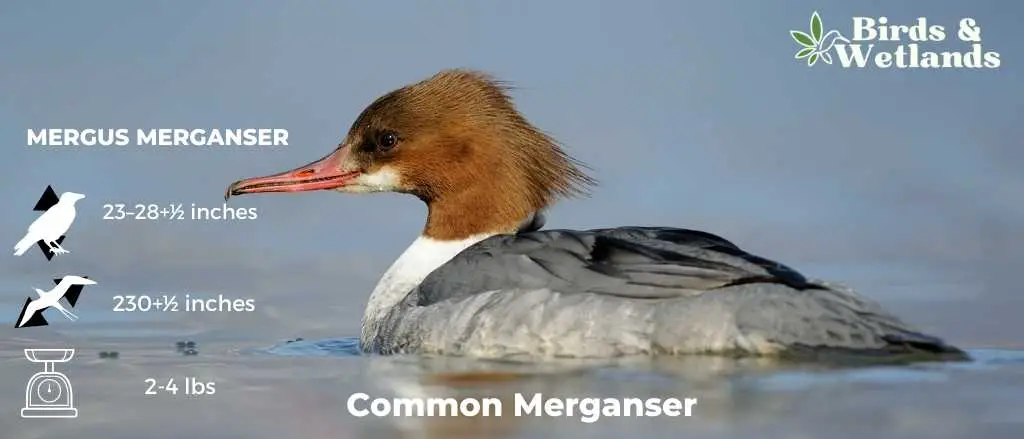
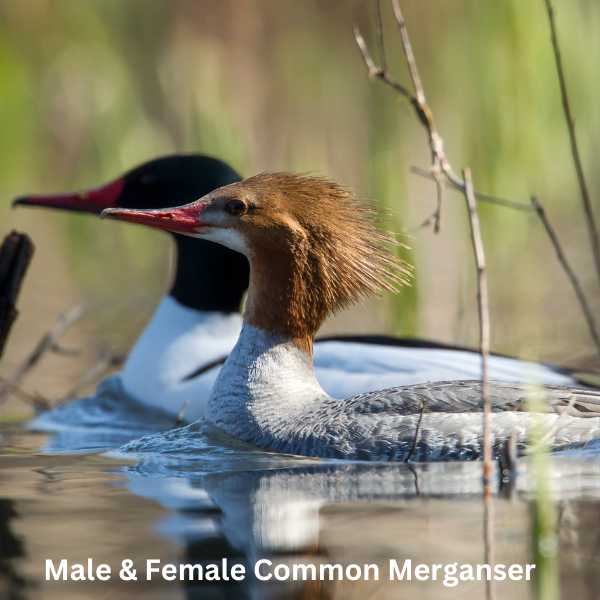
Listen:
Scientific Name: Mergus merganser
Length: 23–28 in
Wingspan: 30 – 38 in
Weight: 2 lb 0 oz – 4 lb 10 oz
The Common Merganser is a large and elegant diving duck, famous for its unique fishing abilities and seen often in the lakes, rivers, and coastal areas across North America.
Appearance: The male Common Merganser is quite striking with its dark green, almost black, crested head, bright red bill, and white body tinged with salmon-pink. The females have a reddish-brown crested head, a white neck, and a grayish body, but share the same red bill as the males.
Diet: True to their diving duck status, Common Mergansers are exceptional hunters, primarily feeding on fish. They’re also known to consume aquatic invertebrates and, on occasion, small mammals and birds. Their serrated bills are specialized to hold slippery fish tightly.
Reproduction: Like the Wood Duck, Common Mergansers also nest in tree cavities or nest boxes close to water bodies, but can also use rock crevices or holes in the ground. A clutch usually contains 9 to 12 eggs, incubated solely by the female.
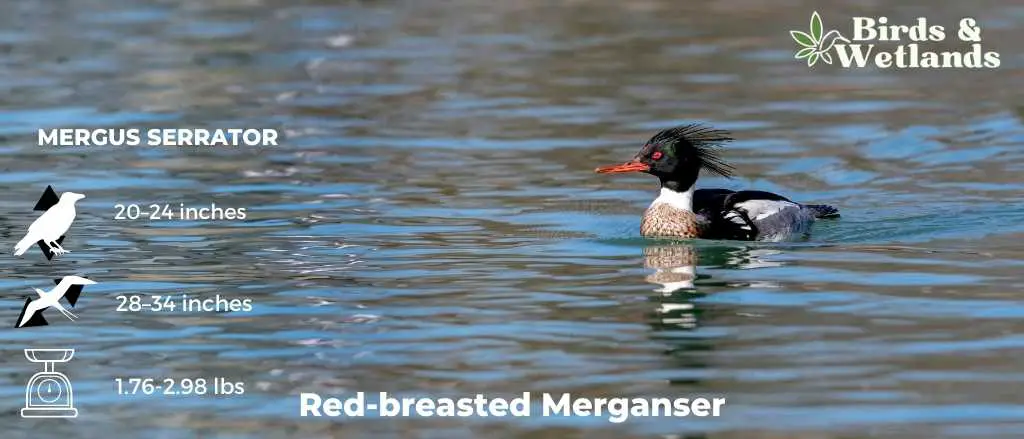

Listen
Scientific Name: Mergus serrator
Length: 20–24 in
Wingspan: 28–34 in
Weight: 28.2 to 47.6 oz
The Red-breasted Merganser is a fascinating diving duck species, recognized for its swift flight and exceptional diving capabilities. They inhabit freshwater and saltwater environments and are quite common in North America and Eurasia.
Appearance: The Red-breasted Merganser boasts an interesting appearance. Males display a dark green head, bright red eyes, and a distinctive, long reddish-brown breast. Their bodies are mainly grey, and they also have a white collar and a thin, serrated bill. Females are more subdued, featuring a rusty cinnamon head with a shaggy crest and grey body.
Diet: Predominantly includes small fish, which they catch by diving underwater. They can also feed on aquatic insects, crustaceans, and occasionally amphibians. Their serrated bill helps them grip slippery prey effectively.
Reproduction: The breeding ground for Red-breasted Mergansers is typically near freshwater lakes or rivers. Females build nests in tree cavities, on the ground hidden in vegetation, or use abandoned nests of other birds. The female lays a clutch of 6 to 12 eggs.
American Coot
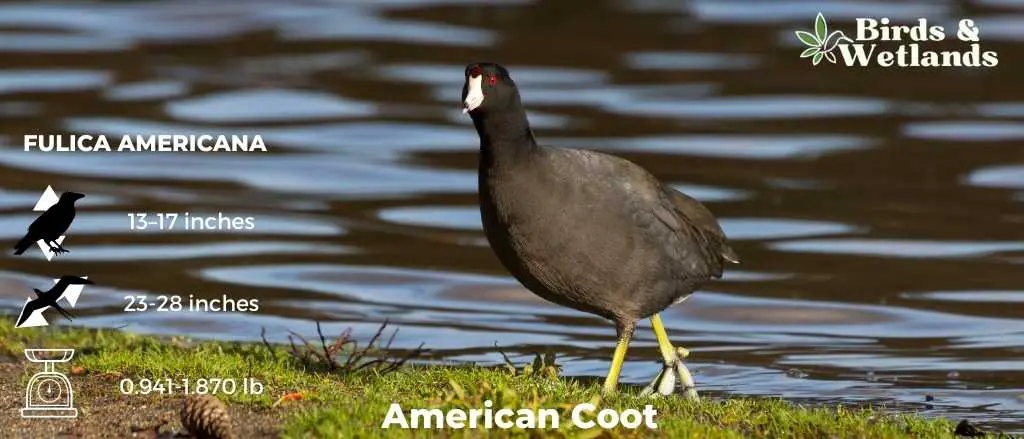
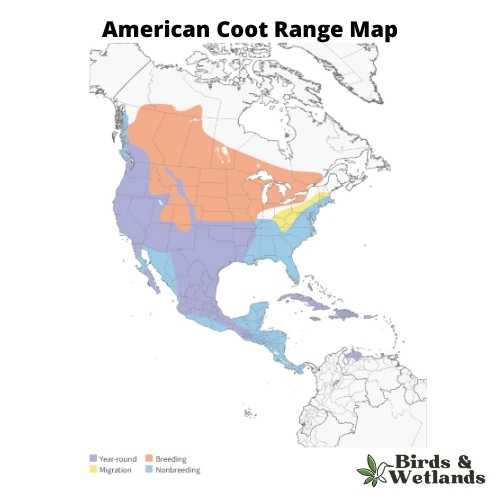
Listen:
Scientific Name: Fulica americana
Length: 13–17 in
Wingspan: 23 to 28 in
Weight: 1.270 to 1.870 lb
The American Coot is a ubiquitous water bird commonly seen in the wetlands, lakes, and ponds of North America, recognized for its adaptability and striking features.
Appearance: American Coots are easily identifiable by their slate-gray bodies, offset by a white, chicken-like bill and a red eye. Their legs are also distinctive, equipped with lobed toes, as opposed to the webbed feet seen in ducks, which assist them in navigating both land and water adeptly.
Diet: While aquatic plants form the bulk of an American Coot’s diet, they aren’t strictly herbivores. These versatile birds also consume small invertebrates and fish, demonstrating their ability to adapt and survive in a variety of habitats.
Reproduction: Nesting for the American Coot usually happens in shallow water bodies, where they construct a floating nest hidden among the vegetation. A clutch can contain between 8 to 12 eggs, all of which are incubated by both parents.
Sandhill Crane
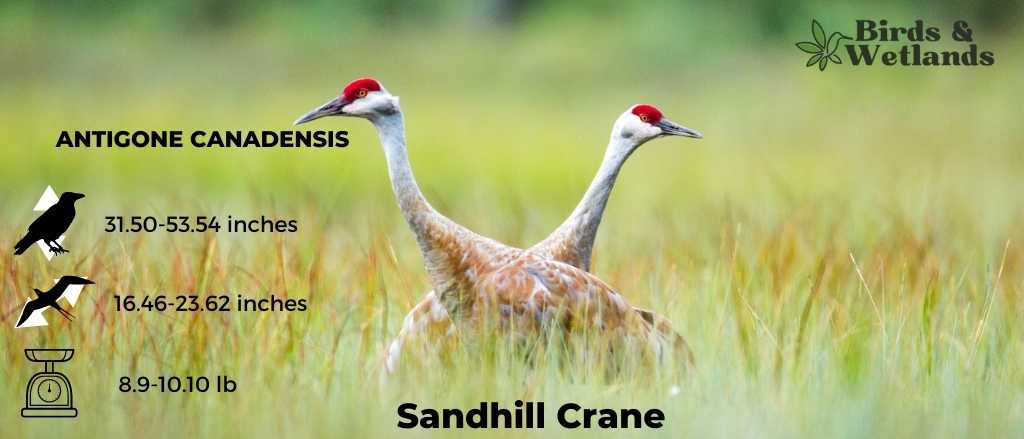

Listen:
Scientific Name: Antigone canadensis
Length: 2 ft 7-4 ft 6 in
Wingspan: 16.5–23.6 in
Weight: 4 – 4.5 kg
The Sandhill Crane is a tall, elegant bird known for its impressive size and striking appearance. They are found across North America, in habitats ranging from wetlands to grasslands.
Appearance: Sandhill Cranes are recognized for their tall stature, gray body, long legs, and long neck. Their most distinctive feature is a red forehead, which contrasts with their otherwise primarily gray plumage. During the breeding season, their gray feathers often take on a rusty-brown hue due to them rubbing iron-rich mud onto their feathers.
Diet: Sandhill Cranes are omnivorous birds and their diet is quite diverse, consisting of seeds, grains, berries, insects, small mammals, reptiles, and amphibians. They are known to forage while walking in shallow water or in fields.
Reproduction: Sandhill Cranes mate for life and their complex courtship dance is a sight to behold. They nest in marshy areas and the female typically lays two eggs.
American Wigeon
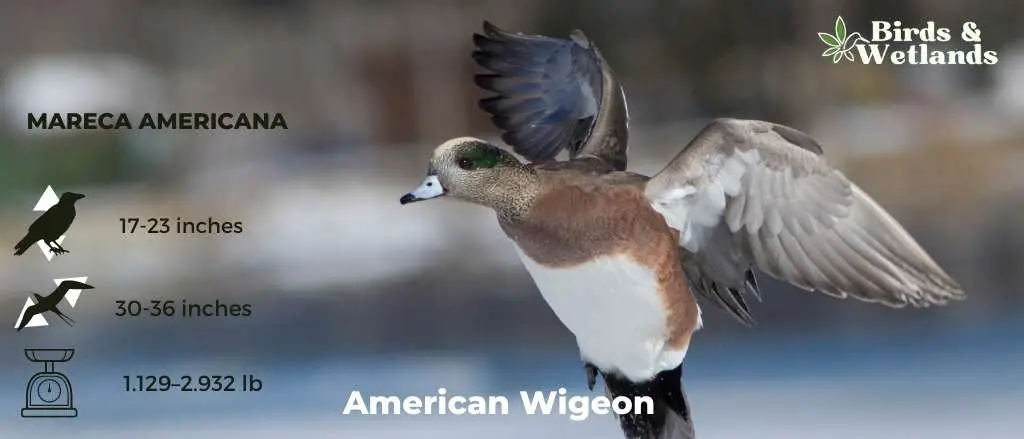
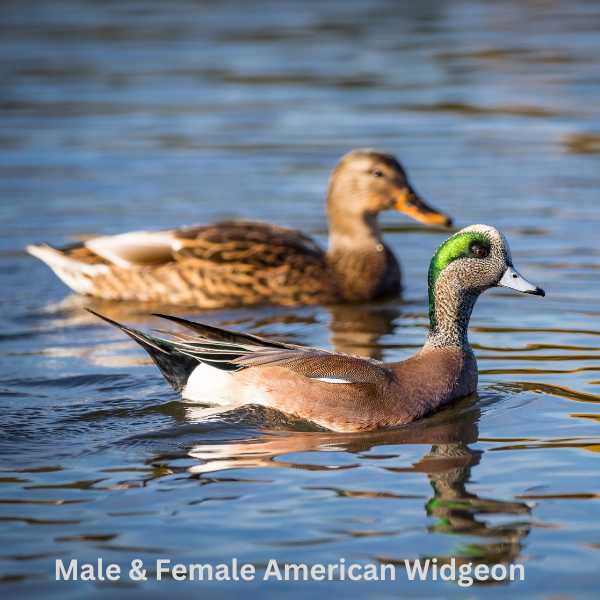
Listen to American Wigeon
Scientific Name: Mareca americana
Length: 17–23 in
Wingspan: 30–36 in
Weight: 1 –3 lb
The American Wigeon is a medium-sized duck species that is a popular sight in wetlands, ponds, and lakes and is often seen in mixed flocks with other ducks.
Males of the species are recognized by their distinctive appearance. They sport a unique white forehead and crown, coupled with a green band stretching from the eye to the back of the head. The body is mainly gray with a pinkish hue on the chest. Females are more subdued in color, with primarily gray and brown tones.
Diet: comprising mainly plant material like aquatic vegetation and grasses, but it also includes insects and other small invertebrates. They are known for a feeding behavior called “kleptoparasitism,” where they often snatch food from other ducks.
American Wigeons usually breed in the northernmost parts of North America. The females create their nests on the ground, often hidden in tall grass near water bodies. They lay a clutch of 6 to 11 eggs which they incubate for about three to four weeks and the ducklings feed on small aquatic invertebrates and aquatic insects.
Osprey (Pandion haliaetus)
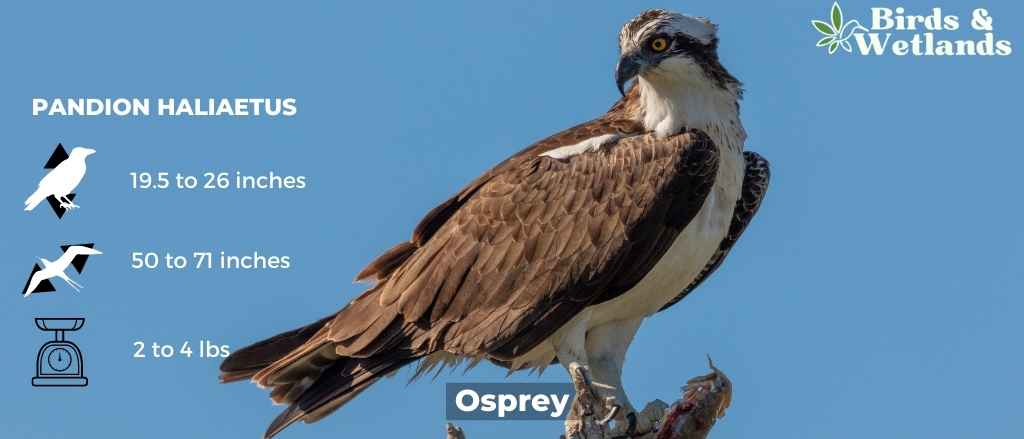
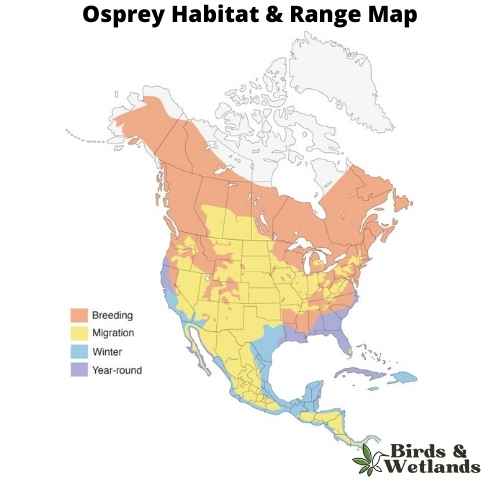
Osprey Sound
Scientific Name: Pandion haliaetus
Length: 50–66 cm (19+1⁄2–26 in)
Wingspan: 127–180 cm (50–71 in)
Weight: 0.9–2.1 kg (2 lb 0 oz – 4 lb 10 oz)
The Osprey, a fascinating bird of prey, is universally known for its exceptional hunting prowess and striking physical characteristics. Osprey are dark brown hawks on the upperparts, contrasting beautifully with the predominantly white underparts, and a distinctive dark band that stretches across the eyes towards the sides of its head.
Equipped with specialized talons and a reversible outer toe, the Osprey’s hunting strategy involves a spectacular plunge-dive into bodies of water, often emerging with a fish securely gripped in its claws.
Found on every continent except Antarctica, the Osprey is a cosmopolitan species favoring habitats near water bodies such as lakes, rivers, and coastal areas, reflecting its piscivorous diet. This bird has a diet almost exclusively of fish, making it a unique member of the raptor family and often referred to as the sea hawk or fish hawk. They locate their prey from the air, often hovering before plunging feet-first to capture a fish. When it comes to breeding, Ospreys are monogamous, often mating for life.
They construct large, bulky nests made of sticks, lined with softer materials, and prefer elevated or isolated areas such as treetops or artificial structures like utility poles. Both parents share the responsibility of incubating the eggs and rearing the chicks.
Common Loon

Listen:
Scientific Name: Gavia immer
Length: 24-39 in
Wingspan: 50-56 in
Weight: 6.4-13.6 lbs
The Common Loon is a large, iconic water bird that can be found in many parts of North America. It is known for its haunting calls, often heard in the early morning or late evening across the region’s lakes and ponds.
Appearance: The Common Loon is celebrated for its striking black-and-white breeding plumage, a red eye, and a robust, black bill. In winter, its plumage turns to a more subdued gray, but its large, sturdy body and pointed bill remain distinctive.
Diet: Common Loons primarily feed on fish, but also consume crustaceans, frogs, and aquatic insects. They are expert divers, capable of plunging deep underwater to catch their prey, and are often observed popping their heads above water before diving for their next meal.
Reproduction: The Common Loon nests near water, typically on lakes and larger ponds in the northern parts of North America. The female generally lays 1-2 eggs per year in a nest made from vegetation on the ground. Both parents share the responsibility of incubating the eggs and feeding the young.
Pied-billed Grebe
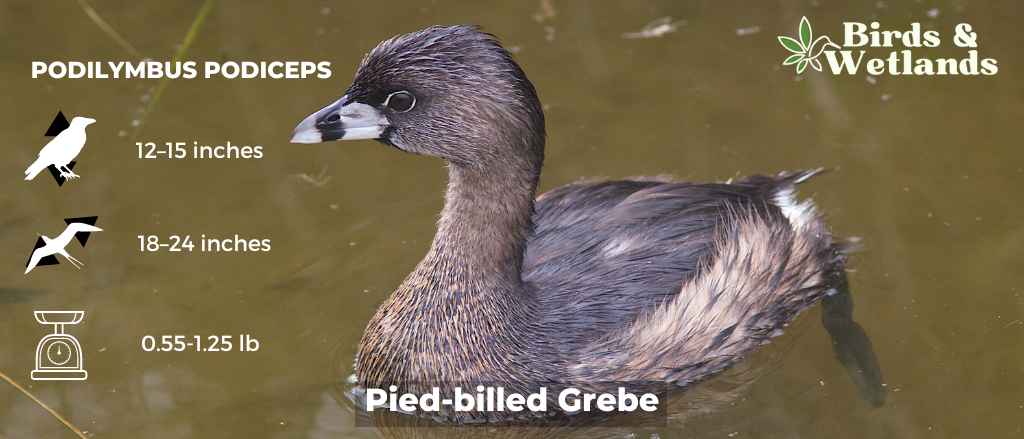
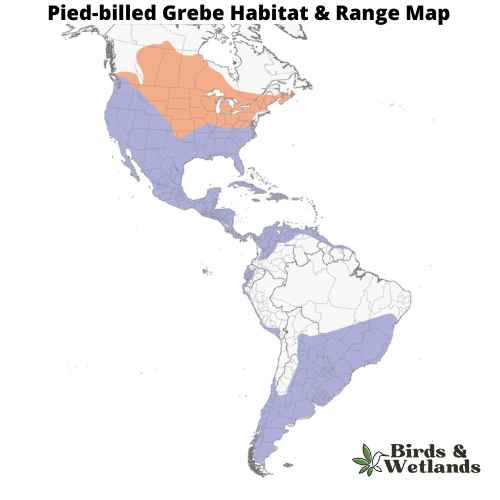
Listen:
Scientific Name: Podilymbus podiceps
Length: 12–15 in
Wingspan: 18–24 in
Weight: 8.9–20.0 oz
The Pied-billed Grebe is a small, elusive water bird well-known for its unique ability to adjust its buoyancy and often “sink” out of sight. It can be found in a wide variety of wetland habitats across the United States.
Appearance: Pied-billed Grebes have a stocky build with a short neck and a chicken-like bill that is conspicuously ringed in black during the breeding season – hence the name “pied-billed”. Their plumage is primarily a muted brown, which can vary in tone depending on the season.
Diet: Their diet consists predominantly of aquatic invertebrates, small fish, and amphibians. Pied-billed Grebes are adept divers and can stay underwater for impressive lengths of time to catch their prey.
Reproduction: Pied-billed Grebes usually nest in dense marsh vegetation, where the female lays 5 to 7 eggs. Both parents share responsibilities for incubation. After hatching, the chicks are often seen riding on their parents’ backs while they learn to navigate their aquatic world.
Ring-billed Gull (Larus delawarensis)
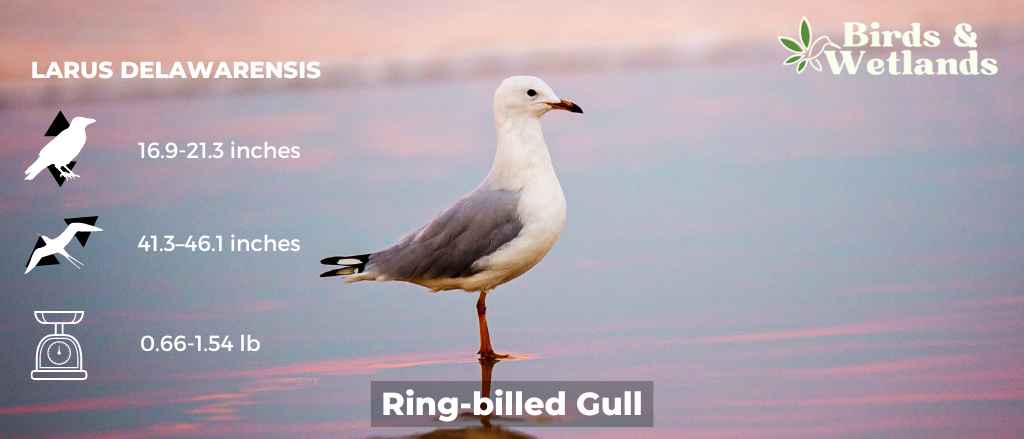
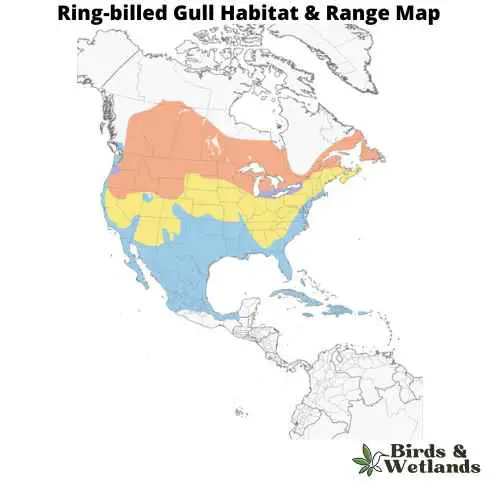
Listen:
Scientific Name: Larus delawarensis
Length: 16.9-21.3 in
Wingspan: 41.3–46.1 in
Weight:10.6-24.7 oz
The Ring-billed Gull is a common North American gull species recognized for its distinctive bill markings and widespread presence, particularly around human habitats.
Appearance: Ring-billed Gulls have a light-gray back, white head and underparts, and yellow eyes. Their most notable feature is the black ring around their yellow bill, which gives the species its name.
Diet: They have a varied diet that includes fish, insects, earthworms, rodents, grain, and garbage. They’re known for their opportunistic and scavenging feeding behaviors, often found near human-populated areas.
Reproduction: Ring-billed Gulls typically nest in large colonies on the ground near bodies of water. The female usually lays two to three eggs per season.
Herring Gull (Larus argentatus)


Listen:
Scientific Name: Larus argentatus
Length: 22.1-26.0 in
Wingspan: 53.9–57.5 in
Weight: 28.2-44.1 oz
The Herring Gull is a versatile bird often found near coastlines, known for its distinct call and adaptive lifestyle.
Appearance: Herring Gulls have a white body, gray back, and yellow bill with a red spot. Juvenile gulls are brown, becoming whiter as they age.
Diet: These gulls are opportunistic eaters. They consume a variety of food, including fish, insects, small birds, carrion, and human refuse.
Reproduction: Herring Gulls nest in colonies on islands or cliffs, laying two to three eggs per season. Both parents share incubation and chick-raising responsibilities.
Great Black-backed Gull (Larus marinus)
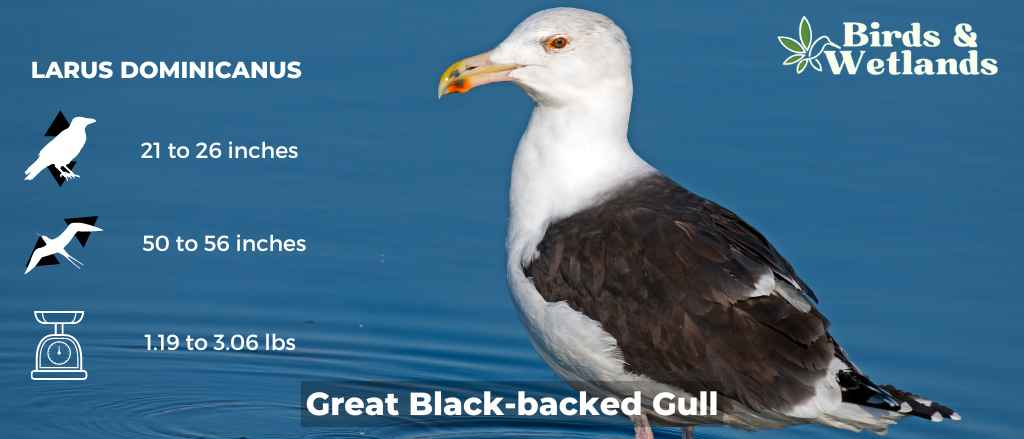
The Great Black-backed Gull is a large, sturdy gull that has a wingspan of up to 3 feet. It has distinctive black markings on its back and a yellow bill with red at the tip.
- Scientific Name: Larus marinus
- Length: 64–79 cm (25–31 in)
- Wingspan: 1.5–1.7 m (4 ft 11 in – 5 ft 7 in)
- Weight: 0.75–2.3 kg (1 lb 10 oz – 5 lb 1 oz)
Great Black-backed Gull Description
It has a black back, white cheeks, a yellow bill, and red legs. It has a strong territorial instinct, which can make them aggressive toward other birds and humans alike. They are known for their loud calls and their ability to soar for hours without flapping their wings.
Great Black-backed Gull Sound
Great Black-backed Gull Habitat & Range
This gull lives all over Europe, Asia, and North America. It lives in coastal areas and can be found on beaches and near freshwater lakes. There are two populations, one in North America and one in Europe.

Great Black-backed Gull Diet
The Great Black-backed Gull’s diet consists mostly of fish, insects, small mammals, and birds. They hunt for food by spotting prey from high above and swooping down to catch them with their claws. They will also scavenge for food on land or on the water’s surface when necessary.
Great Black-backed Gull Nesting
This species nests in colonies on cliffs or islands, sometimes laying eggs in trees when no appropriate nest sites are available. They lay three to five eggs each year.
These birds form monogamous pairs during the breeding season, which lasts from April through June depending on location; they will mate for life after finding their perfect partner. After mating, they build nests made out of sticks lined with seaweed or grass, which they place high up in trees or cliffs so they can see over long distances easily while keeping an eye on their eggs at all times.
Caspian Tern (Hydroprogne caspia)

The Caspian Tern is a small seabird with a long, pointed bill and long, pointed wings.
- Scientific Name: Hydroprogne caspia
- Length: 48–60 cm (19–24 in)
- Wingspan: 127–145 cm (50–57 in)
- Weight: 530–782 g (18.7–27.6 oz)
Caspian Tern Description
It has a black cap and back with white cheeks and underparts. It has a dark brown back and wings. Its bill is yellow at the base turning black toward the tip. Its legs are pinkish-red. The body is white, with a black cap and tail.
Caspian Tern Sound
Caspian Tern Habitat & Range
Its habitat includes lakes, rivers, ponds, marshes and estuaries. It can be found in the wetlands and around the coast of Central Asia, including Iran, Afghanistan, Pakistan and India. In the winter months, it migrates south to Africa, India, and Australia.
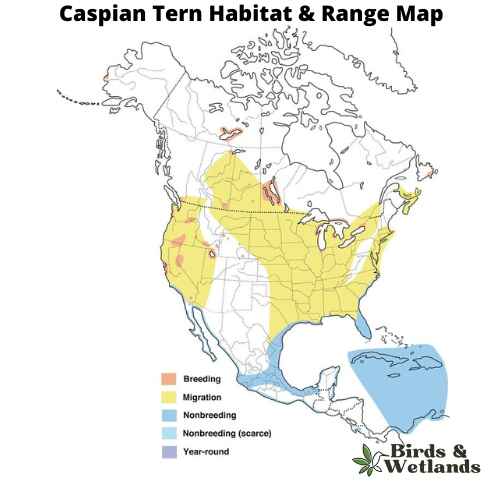
Caspian Tern Diet
The Caspian Tern feeds on fish, crustaceans and insects. They have been known to dive up to 65m (200 feet) below the surface of water to catch their prey. They will also steal food from other birds such as gulls or crows by swooping down onto their backs while they are feeding on the surface of water so they can take food right out of their bills.
Caspian Tern Nesting
They nest colonies on islands or coastal areas, trees near lakes or large rivers that are surrounded by marshes where there are lots of insects for them to eat during breeding season (April-May). These nests are made from twigs lined with grasses or other soft material that protects eggs from falling out if wind blows them off their perch. The Caspian Tern’s population is stable but declining due to habitat loss and pollution.
Where to Spot Vermont’s Water Birds
Missisquoi National Wildlife Refuge, Swanton: This refuge consists of extensive wetlands and is home to over 200 species of birds. It is known for its water bird populations including the American Black Duck, Wood Duck, and Green-winged Teal.
Dead Creek Wildlife Management Area, Addison: A popular location for bird watchers, Dead Creek is best known for the fall migration of Snow Geese. It also provides a habitat for a variety of waterfowl, shorebirds, and marsh birds.
Lake Champlain: As the largest freshwater body in the state, Lake Champlain attracts a variety of water birds. Species such as the Common Loon, Great Blue Heron, and various duck species can be observed here.
Sandbar State Park, Milton: Situated on the broad lake plain of Lake Champlain, this state park is a nesting habitat for many species of waterfowl. It’s a great place to spot ducks, gulls, and other water birds.
Bomoseen State Park, Fair Haven: The park’s swamp and marsh areas are home to many water birds, including various duck species, Great Blue Herons, and Belted Kingfishers.
| Neighboring State | Best Spots for Birdwatching |
|---|---|
| New York Water Birds | Montezuma National Wildlife Refuge, Central Park, Jamaica Bay Wildlife Refuge |
| New Hampshire Water Birds | Great Bay National Wildlife Refuge, Massabesic Audubon Center, Lake Winnipesaukee |
| Massachusetts Water Birds | Parker River National Wildlife Refuge, Cape Cod National Seashore, Plum Island |
FAQS About Waterbirds in Vermont
What birds are common in Vermont?
Vermont, located in the northeastern United States, is home to a variety of bird species due to its mixed forests, wetlands, and open fields. Some common birds found in Vermont include:
- American Goldfinch – The state bird of Vermont, it is bright yellow in the summer and olive-brown in the winter.
- Black-capped Chickadee
- Northern Cardinal
- American Robin
- Red-tailed Hawk
- Blue Jay
- Tufted Titmouse
- Downy Woodpecker
- Common Loon – Especially in the northeastern lakes during summer.
- Turkey Vulture
What is the famous bird from Vermont?
The most famous bird from Vermont is the American Goldfinch, primarily because it is the state bird.
What is the bright yellow bird in Vermont?
The bright yellow bird you’re thinking of is again the American Goldfinch, especially the males during the summer breeding season.
It’s worth noting that while the American Goldfinch is bright yellow during the summer, its plumage changes in the winter to a more muted olive-brown. The females and juveniles are not as bright as the adult males but still have some yellow tones.
In Vermont, wild birds flourish in areas with dense vegetation. Among the medium-sized birds and wading birds, little blue herons with their dark gray plumage stand out. Additionally, the majestic bald eagles can often be spotted soaring above the state’s waterways.

